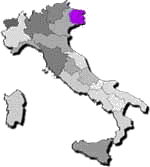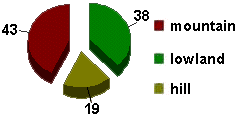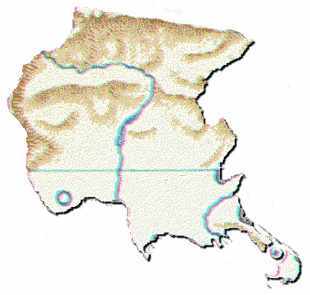 |
FRIULI VENEZIA |
 Back to Italy |
| Provinces
- This region has 4 provinces: Gorizia, Pordenone, Trieste, Udine Chief town - Trieste Surface - kmq 7846 National Parks - any national park  Russian Version |
 |
|
|
||
 |
FRIULI VENEZIA |
 Back to Italy |
| Provinces
- This region has 4 provinces: Gorizia, Pordenone, Trieste, Udine Chief town - Trieste Surface - kmq 7846 National Parks - any national park  Russian Version |
 |
|
|
||
 |
Origin of the Name |
| Reliefs - Passes - Coasts - Islands | |
| Landscape | |
| Agriculture - Stock-Farm - Fishing | |
| Industry - Tourism | |
| Position and Frontier | |
| Rivers - Lakes | |
| Climate | |
| Population | |
| Communication |
Origin of the name:
The name of this region points out a composition of two zones
of geographical lists, all but two derive from the Latin ‘gens Iulia ' (the family to
which Giulio Cesare belongs). Friuli originally ‘Forum Julii ' was the name of a
commercial center (forum means market), built by the Romans in the actual city of
Cividale. The name of the city then been extended to the whole region. Instead Venice
Giulia is a recent name that honors the Venetian inhabitants and the ‘Gens Iulia
'. After the first World War the territory of the region belonged to Veneto, together with
some zones of what is now ex-Yugoslavia. After the second world war nine regions of Venice
Giulia were lost andincluding Friuli with what had remained of the actual Region on which
it was founded.
The Footstep of Mauria puts the valley of Tagliamento
in communication with that of Piave, passing the Prealpis Carniche.
The lowland of this region is the natural part of the Lowland Padana. It introduces the
same characteristics and it is divided and tall, mildly productive while the low part is
very productice and irrigated by the risorgives.
Landscape:
Also part of this great region, is Friuli Venice Julia
which introduces notable aspects of its territory. Going down from north we find the
mountains that exalt their peaks with big woods filled with firs, then the well taken care
of level part and its agricultura crops and also the abundance of water of the
rivers that end in the sea of the calm lagoon waters. In the part of the oriental coast we
find an ample gulf that shoulders and extendeds to the highland of Carso. Always in the
oriental part there is a zone hilly and rich in vineyards, closes the region in the
Italian territory by its border. The western section of the inclusive coast, between the
mouth of Tagliamento and Isonzo are introduced low and sandy. The coast is
formed by the deposits, unloaded by the waters from the rivers Tagliamento and Isonzo. In
1976 a big part of the Friuli was struck by a disastrous earthquake. Two seismic shakes
demolished the area a small distance to the north. The phenomenon prouduced lot of victims
and destroyed a big part of the 117 communes of the provincies of Udine and Pordenone. The
reconstruction proceeds too slowly still in comparison to the vast consequences of the
sisma.
In Friuli Venice Julia many appreciated wines are produced exported all over the world, of which Tocai and Merlot are memorable. The characteristic production is that of grappa. The breeding of the meat cattle and from milk is very intense, besides those of the swines of which we find products of good quality. After Veneto, the Region holds the second place for the breeding of the silkworm, which is however losing of importance with the advent of the artificial fibers. The principal fish harbors are: Trieste, Monfalcone and Degree. The fishing is becoming less and less profitable, because the sea here is more and more poor of fish.
Industry - Tourism:
Important are the metallurgical fittings, mechanics,
chemical products, the fittings for the refinement of oil and big shipyards, which have
assembled especially in the zones in Trieste, Monfalcone, Pordenone and Gorizia. A lot of
middle firms produce agricultural cars, textiles, coffee prducts, in addition to clocks,
alimentary, paper, furniture and chairs.
Position and Frontier:
Friuli Venice Julia is the north-most oriental region of this
Italian territory. The surface goes from the Alps to the Adriatic Sea. To north the Friuli
Venice Julia bourders Austria, to east Slovenia (ex-Yugoslavia), to south the
Adriatic Sea and to west we find Tagliamento and Livenza that divide it from Veneto.
Rivers - Lakes:
The principal rivers of this Region are:Tagliamento, Isonzo
and Livenza. Tagliamento is born from the strata of the Footstep of the Mauria and flows
in the Venetian zone. Of Isonzo, that goes down of the Tricorno Mountain, only the
inferior part of the course and its tributary, the river Tower, belongs to Italy. Livenza,
even if for a brief stretch bathes the lands border with Veneto. Memorable are the most
famous as well as some other rivers of this Region, or rather Timavo, and phenomenon
typical of Carso, that the most ancient populations already had the opportunity to study.
The Timavo is born in Slovenia, it flows underground for 38 kms. and emerges next to
Monfalcone, to little distance from the sea.
Climate:
Thanks to the protection of the Alps Carniche and the
proximity of the sea, the climate in the level part is generally a maritime type, without
highly elevated temperatures; in the northern part of the region the climate is typically
alpine. In the Carso there are abundant precipitations. Where there is no protection
from the barrier of the Alps there blows the icy ‘bora ', a cold and icy wind,
but that brings the beautiful time; it succeeds in reaching the 100 km/hs with gusts that
touch 150 km/hs; and reach the coasts even to marchigiane crossing the Adriatic. To
Trieste we find the bora, mild ten times the year, which is also introduced as a
moderate wind, commonly called ‘borin '.
Population:
Friuli Venice Julia is a region of special statute.
Being an frontier land there are present in its territory Slavic ethnic minorities
who speak the language slovena and anothers of the German language. The populated zones
are the lowland and the coastal band, while the mountainous and alpine parts recording
more and more of a demografic diminution about how much the population prefers to move to
the cities of the coast or the lowland or other zones of northern Italy which are more
industrialized.
Communication:
Trieste is the release of railway communication for Venice,
for Austria passing for Udine and Tarvisio, and for the zone of ex-Yugoslavia. The road
and motorway net puts in connection the whole territory with the Lowland Padana, Austria
and ex-Yugoslavia. The small centers are in operation on different release roads and
railways. The airport of the Region is found to Ronchi of the Legionaries (GO).
Web Site designed by MediaSoft - © Copyright 1998-1999 - All rights reserved